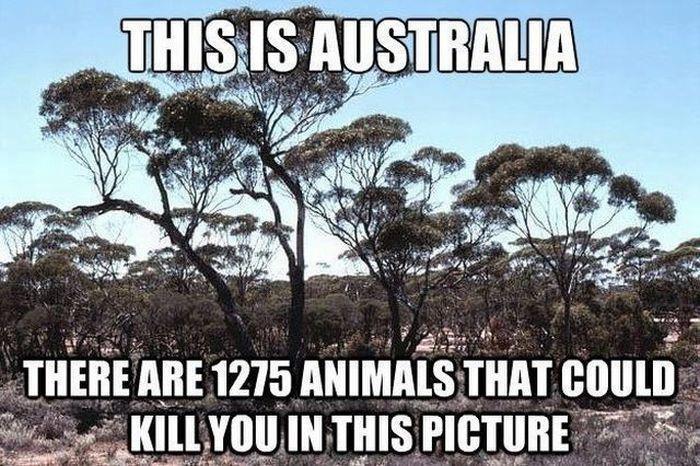
When it comes to creepy crawlies and things that go bump in the night, Australia is up there with the likes of Africa. Thank goodness for the cuddly koala or we’d be in serious trouble! While you’re not likely to see a Taipan or crocodile (or any other scary creature) while walking down the street, it can’t hurt to be clued up about Australia’s most poisonous fauna.
1. The Box Jellyfish
This squishy creature is one of the most lethal animals in the world. It dwells on the coast alongside the Great Barrier Reef and has a powerful venom. The stings are terribly painful and often fatal. Be sure to have a bottle of vinegar in your first aid kit if you’re heading to this neck of the woods.
2. The Taipan
Do you want the good news or the bad news first? The good news is Taipans usually stay away from people, but once cornered or threatened, they strike several times. The Taipan is a large, fast and highly-venomous snake found throughout Australia. It has the most toxic venom of all the species worldwide, has a dark brown colour and is often found in sugar fields where it hunts for rats.
3. Saltwater Crocodile
The Saltwater Crocodile is the stuff of nightmares – it can grow up to 5.45 metres in length and is often found in Thailand, Vietnam and Northern Australia. It’s usually well camouflaged and strikes at an amazing speed. Its most powerful attack (the ‘Death Roll’) consists of grabbing its prey and rolling with it powerfully until it dies.
4. Blue Ring Octopus
Another serious threat for those on an Aussie beach holiday is the Blue Ring Octopus – one of the most toxic sea creatures in the world found off the coast of Australia, New Guinea, Indonesia and the Philippines. Even though the octopus is only the size of a golf ball, there is no known antidote for its powerful venom. It causes motor paralysis, eventually leading to cardiac arrest.
5. Stone Fish
This creature doesn’t win any points in the looks department. Known as the most venomous fish in the world, the Stone Fish lives on the bottom of reefs, camouflaged as a rock. It lives above the Tropic of Capricorn, but can also be found in the Great Barrier Reef. Its venom causes shock, paralysis and tissue death, depending on the severity of the sting. The pain is said to be so excruciating that it can lead to amputating the affected limb. Sorry, there’s no good news to report here.
6. The Red Back Spider
The Red Back Spider is famous for all the wrong reasons – it’s Australia’s most famous deadly spider. The red striped spider’s venom induces severe pain, but thankfully, deaths are rare. Thousands of people are bitten, but only approximately 20% of the victims require treatment. Generally, the children and the elderly are the most exposed to the spider’s threat.
7. Brown Snake
Known as one of Australia’s most deadly creatures, the Brown Snake’s venom quickly kills if left untreated. Even young snakes are capable of delivering a fatal bite to humans.
8. Tiger Snake
The Tiger Snake is yet another of the many venomous snakes found in Australia, particularly in the southern regions. These striped snakes are generally not aggressive and retreat whenever they have the chance. Although anti-venom is readily available, mortality rates are around 45% if the bite is left untreated.
9. Funnel Web Spider
Here’s another one for all you arachnophobes out there. The darkly-coloured Funnel Web Spider resembles a Tarantula and has fangs that can penetrate fingernails or shoes. It can be found in the eastern coast of Australia, New South Wales, Victoria and Queensland. First aid consists of applying a bandage and wrapping the bitten limb. As with other spiders, the main treatment is the anti-venom.
10. Great White Shark
We’ve saved the scariest ‘til last. This exceptionally large shark known as the ‘White Death’ is the largest predatory fish on earth. It can be found in great numbers on the southern coasts of Australia. The good news is it doesn’t target humans as prey. Phew.
– See more at: http://www.hotelclub.com/blog/the-10-most-dangerous-animals-in-australia/#sthash.SRUE2qM7.dpuf

